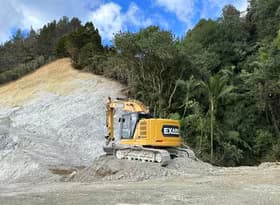
Thirty-six thousand new homes isn’t what it used to be
The annual total of new dwelling consents slipped to 36,453 in January 2024, down 29% from its May 2022 peak. The sharp drop in consents over the last two years probably overstates the downturn in residential construction activity, just as the strong and persistent growth in consent numbers between 2011 and 2022 overstated the lift in activity during this period. The divergence arises partly because the number of dwellings being completed did not increase anywhere near as much as consents, but also because the average size of new dwellings has been shrinking. This article explores the effects of the latter on activity levels in the residential construction industry.
Building fewer houses, and smaller ones too
Although the annual consent total is at its lowest since September 2019, the total floor area associated with those consents over the last year has not been smaller since April 2016. At that point in time, the annual consent total was way down at 28,038.
Behind this divergence between consent numbers and floor area are two drivers. Firstly, as Chart 1 shows, the proportion of new dwellings represented by standalone houses has declined from 84% in 2010 to 43% over the last 12 months (getting as low as 41% during 2023). Standalone houses are, on average, anywhere between 70% and 115% bigger than attached dwellings, so this change in the mix of dwellings has significantly reduced the volume of work associated with each consent.
Secondly, Chart 2 shows that the average floor area associated with each consent, when split by type, has also declined since 2010. The average new standalone house has shrunk from 216m2 in 2010 to 183m2 over the last year, a decline of 15%. Land and housing affordability issues have been the main driver of this trend. The average size of new attached dwellings has also decreased, from 115m2 to 107m2. However, this decline is little more than normal year-to-year variation – the average size of new attached dwellings has been generally steady throughout the last three decades.
Chart 3 demonstrates the effects that each of these two trends have had on the volume of work associated with residential consents since 2010. The annual total floor area of consents is compared to two other lines: one with the mix of dwelling consents held at its 2010 proportions (84% houses, 16% attached dwellings); and the second with this mix of dwellings as well as the average floor area that prevailed in 2010.
If the 2010 mix of consents had continued through until 2022, the annual total floor area would have peaked at 9.2 million square metres, rather than the 7.7 million square metres recorded. This result would have represented an additional 32 percentage points of growth from its 2010 level. If we make the additional assumption that the 2010 average size of new dwellings had also continued, then the annual total floor area would have reached 10.2 million square metres in 2022, representing an additional 53 percentage points of growth from its 2010 level. In other words, the changing size and composition of residential building stripped about one third off the growth in activity that consent numbers on their own suggested.
Urban centres are most affected by the trend
Not all parts of the country have been affected equally by these changes. Chart 4 shows the districts and cities with the largest declines in the share of new dwellings made up of standalone houses between 2010 and 2023. For some areas, such as Kapiti Coast, Horowhenua, and South Wairarapa, the high number of attached dwelling consents in the last year looks like an outlier. But the other areas represent a clear trend towards intensification occurring throughout New Zealand’s urban areas, as high land prices and changing zoning rules have resulted in smaller and denser dwelling types being favoured.
Unsurprisingly, many of these areas are also among the ones with the largest decline in the average floor area of new dwelling consents over the last 13 years (see Chart 5). Alongside the likes of Auckland and Hamilton, the size of new homes in Christchurch, Selwyn, and Waimakariri has dropped substantially, with the latter two becoming increasingly viewed as satellite centres within the Greater Christchurch urban area. The appearance of Palmerston North also indicates that the affordability pressures and changing preferences are being seen in the regional centres as well.
But there are still a few areas where bigger homes are in vogue. Five districts recorded larger average new home sizes in 2023 than in 2010. These areas might have been viewed as less attractive locations to live previously, with the new homes that were being built smaller on average, reflecting lower incomes and wealth levels. However, some people wanting to build a larger home are now likely to find that lower land prices make these locations more cost-effective than the neighbouring urban centres of Auckland, Hamilton, Dunedin, etc. Of the 10 areas shown in Chart 6, Hurunui is the only area that had a larger new dwelling size than the nationwide average in 2010 (all areas have a larger new dwelling size than the nationwide average in 2023).
More shrinkage on the way
We publish forecasts of the average floor area for new dwellings, split into houses and attached dwellings, as part of our regular Building Forecasts. We expect the average size of new houses to continue trending downwards throughout the next five years, due to ongoing housing affordability issues, sustained high building costs, changing demographics such as shrinking family sizes, and more permissive zoning for higher density houses (such as no requirement to provide off-street parking). Our February forecast, shown in Chart 7, predicts the average new house size shrinking to 179m2 by 2028, the smallest since 1998/99.
We also forecast that attached dwellings will continue to make up around 60% of all new dwelling consents. In the near-term, the effects outlined above, in combination with weak economic conditions, could see the average size of new dwellings get as low as 134m2. That result would be the smallest average size for all new homes since 1990.
Economic theory states that, for a “normal” good, price rises result in less of that good being consumed. Although there are other non-price factors that also determine people’s demand for housing, the experience of the last 15-20 years suggests that people are “consuming” less housing (by way of smaller new houses) than in prior decades. In other words, they are responding to high house prices and building costs in an expected manner.
The National-led government’s plans to improve the supply of land for housing and reduce the costs associated with residential development present upside risks to our forecasts of the average floor area and, as a result, overall volumes of residential construction. However, the current housing affordability problems have evolved over several decades, and we suspect it will take longer than our five-year forecast horizon for government initiatives to successfully remedy New Zealand’s housing issues.











